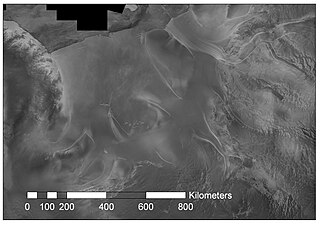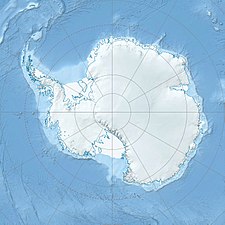
Vinson Massif is a large mountain massif in Antarctica that is 21 km (13 mi) long and 13 km (8 mi) wide and lies within the Sentinel Range of the Ellsworth Mountains. It overlooks the Ronne Ice Shelf near the base of the Antarctic Peninsula. The massif is located about 1,200 kilometres (750 mi) from the South Pole. Vinson Massif was discovered in January 1958 by U.S. Navy aircraft. In 1961, the Vinson Massif was named by the Advisory Committee on Antarctic Names (US-ACAN), after Carl G. Vinson, United States congressman from the state of Georgia, for his support for Antarctic exploration. On November 1, 2006, US-ACAN declared Mount Vinson and Vinson Massif to be separate entities. Vinson Massif lies within the unrecognised Chilean claim under the Antarctic Treaty System.

Brazilian Antarctica is the Antarctic territory south of 60°S, and from 28°W to 53°W, proposed as "Zone of Interest" by geopolitical scholar Therezinha de Castro. While the substance of that designation has never been precisely defined, it does not formally contradict the Argentine and British claims geographically overlapping with that zone. The country formally expressed its reservations with respect to its territorial rights in Antarctica when it acceded to the Antarctic Treaty on 16 May 1975, making the first official mention of the Frontage Theory, which states (simplified) that sovereignty over each point in Antarctica properly belongs to the first country whose non-Antarctic territory one would reach when travelling north in a straight line from such a point. The Frontage Theory was proposed by Brazilian geopolitical scholar Therezinha de Castro and published in her book Antártica: Teoria da Defrontação.

The Comandante Ferraz Antarctic Station is a permanent Antarctic research station named after the Brazilian Navy Commander Luís Antônio de Carvalho Ferraz (1940–1982), who visited Antarctica many times with the British exploration team and managed to convince his government to create a self-guided Brazilian Antarctic Program.
Drygalski Glacier is a broad glacier, 18 nautical miles long which flows southeast from Herbert Plateau through a rectangular re-entrant to a point immediately north of Sentinel Nunatak on the east coast of Graham Land, Antarctica.
Sabine Glacier is a glacier terminating at the sea between Wennersgaard Point and Cape Kater on the northwest coast of Graham Land, Antarctica.

Rutford Ice Stream is a major Antarctic ice stream, about 290 kilometres (180 mi) long and over 24 kilometres (15 mi) wide, which drains southeastward between the Sentinel Range, Ellsworth Mountains and Fletcher Ice Rise into the southwest part of Ronne Ice Shelf. Named by US-ACAN for geologist Robert Hoxie Rutford, a member of several USARP expeditions to Antarctica; leader of the University of Minnesota Ellsworth Mountains Party, 1963-1964. Rutford served as Director of the Division of Polar Programs, National Science Foundation, 1975-1977.
The Kondofrey Heights are heights that rise to 1,115 metres (3,658 ft) at Skakavitsa Peak, on the southeast side of the Trinity Peninsula, Antarctic Peninsula.
Srednogorie Heights are the heights rising to 1220 m on the northwest side of Trinity Peninsula, Antarctic Peninsula.
The Cayley Glacier is a glacier flowing northwest into the south side of Brialmont Cove, on the west coast of Graham Land, Antarctica.
Pettus Glacier is a narrow deeply entrenched glacier 9 nautical miles long, which flows north from Ebony Wall into Gavin Ice Piedmont between Poynter Hill and Tinsel Dome, Trinity Peninsula, Antarctica.
The Edgeworth Glacier is a glacier 12 nautical miles long, flowing south-southwestwards from the edge of Detroit Plateau below Wolseley Buttress to the ice shelf west of Sobral Peninsula, Graham Land, Antarctica.
The Louis Philippe Plateau is a plateau, about 11 nautical miles long and 5 nautical miles wide, which rises to 1,370 metres (4,490 ft) and occupies the central part of Trinity Peninsula, Antarctica, between Russell West Glacier and Windy Gap.
Sjögren Glacier is a glacier 15 nautical miles long in the south part of Trinity Peninsula, Antarctica. It flows southeast from Detroit Plateau to the south side of Mount Wild, where it enters Prince Gustav Channel.
Russell East Glacier is a glacier, 6 nautical miles long and 3 nautical miles wide, which lies at the north end of Detroit Plateau and flows from Mount Canicula eastward into Prince Gustav Channel on the south side of Trinity Peninsula, Antarctica. This glacier together with Russell West Glacier, which flows westward into Bone Bay on the north side of Trinity Peninsula, form a through glacier across the north part of Antarctic Peninsula.
Victory Glacier is a gently sloping glacier, 8 nautical miles long, flowing east-southeast from the north end of Detroit Plateau on Trinity Peninsula to Prince Gustav Channel immediately north of Pitt Point. It is bounded by Trakiya Heights to the north and Kondofrey Heights to the south.
Erul Heights are the heights rising to 1,083 metres (3,553 ft) at Gigen Peak, located on Trinity Peninsula in Graham Land, Antarctica.
Zavera Snowfield is the glacier extending 18 kilometres (11 mi) in a north-south direction and 16 kilometres (9.9 mi) in an east-west direction on southern Trinity Peninsula in Graham Land, Antarctica. It is located in the northeast foothills of Detroit Plateau, south of Diplock Glacier, north of Mount Wild and northeast of Kopito Ridge. It drains into Prince Gustav Channel in Weddell Sea. The glacier is named after the Bulgarian liberation uprising of ‘Velchova Zavera’ in 1835.
Odrin Bay is a 10 kilometres (6.2 mi) wide bay indenting for 7 kilometres (4.3 mi) the Nordenskjöld Coast in Graham Land, Antarctica. It is entered southwest of Fothergill Point and northeast of Spoluka Point.

The Brazilian Antarctic Program is a program of the Brazilian Navy which has presence in the continent of Antarctica. It coordinates research and the operational support for research in the region. It currently maintains a year-round research station in Antarctica, as well as several seasonal field camps. It also maintains two research vessels that sail in the Antarctic waters.
Desudava Glacier is the 15.5 kilometres (9.6 mi) long and 5 kilometres (3.1 mi) wide glacier on Nordenskjöld Coast in Graham Land, Antarctica situated south of Dinsmoor Glacier and east-northeast of Boryana Glacier.







